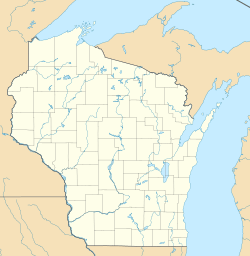Rock Island II Site facts for kids
The Rock Island II site is a special place located on the south side of Rock Island in Door County, Wisconsin, USA. It sits right where Green Bay meets Lake Michigan, inside Rock Island State Park. This site is known as an Early Historic site, meaning it shows signs of human life from when Europeans first arrived. Many Native American tribes lived here, including the Potawatomi, Huron, Petun, and Ottawa people.
Quick facts for kids |
|
|
Rock Island Historic District
|
|
| Location | south side of Rock Island |
|---|---|
| NRHP reference No. | 72000050 |
| Added to NRHP | 1972 |
Discovering Rock Island's Past
People first noticed old cultural items on Rock Island and nearby islands way back in 1915. Later, from 1969 to 1973, experts from Lawrence University dug up the site carefully. They found a huge amount of old items. They also studied old French records.
This research showed that Rock Island was the "Island of the Pouteouatamis" or "Island of the Hurons" mentioned by early French explorers. By looking closely at what they found, the researchers matched four main periods of people living there to Native American groups mentioned in history. These tribes were originally from Michigan and Ontario. They had to move because of big conflicts called the Iroquois Wars.
What Was Found at the Site
The digs from 1969-1973 uncovered many interesting things. They found old structures, tools, and pieces of pottery. They also found human bones, animal bones, and plant remains. These discoveries help us understand how people lived long ago.
Important Features
Archaeologists found several important features at the site. These are signs of human activity that stayed in place:
- 15 pits used for storing food or throwing away trash.
- The remains of 4 buildings, showing where people lived or worked.
- A cemetery with 14 burials, giving clues about their burial customs.
- Trenches that were part of a palisade, which was a strong fence for defense.
Amazing Artifacts
About 80,000 artifacts were collected from the site. Some of these items were made by the Native American people themselves. Others were "trade goods" they got from Europeans.
Here are some examples of what was found:
- Pottery: Over 35,000 pieces of pottery were found. These came from at least 336 different pots!
- Stone tools: Tools made from various types of stone.
- Smoking pipes: Pipes used for ceremonies or daily life.
- Animal effigies: Small figures shaped like animals.
- Catlinite artifacts: Items made from a special red stone.
- Bone and antler tools: Tools crafted from animal bones and antlers.
- European trade goods: These include glass beads, gun parts, lead shot, iron knives, and religious medallions. These items show that Native Americans traded with Europeans.
Different Groups, Different Pottery
Archaeologists used different styles of pottery to figure out which tribes lived at Rock Island II and when. Each tribe often had its own unique way of making pots.
First Potawatomi Group (around 1641-1651 A.D.)
The main type of pottery from this time is called Bell Site Type II. This style was first seen at the Bell Site in Winnebago County, Wisconsin. The people at the Bell Site were also displaced, in their case the Fox tribe.
At Rock Island II, Bell Site Type II pottery was very common during the first Potawatomi period. This led researchers to believe the Potawatomi made this type of pottery. These pots were often round-bottomed with rough surfaces and special designs on the rims.
Huron, Petun, and Ottawa Groups (around 1650-1653 A.D.)
These three tribes lived at the site for a short time, about 2-3 years, between the two Potawatomi periods. These tribes were greatly affected by the Iroquois Wars. The people who survived joined together to form the Wyandot tribe.
The pottery from this time included styles known to the Huron and Petun tribes. It also had some older styles that continued into this historic period. These pots had different shapes, surface textures, and rim designs.
Main Potawatomi Group (around 1670-1730 A.D.)
The most common pottery type during this longer occupation was again Bell Site Type II. However, other types were also found. One example is Bell Site Type I, which was common with the Fox tribe. Another was Aztalan Collared pottery, which shows connections to older prehistoric groups.
Ottawa Group (around 1760-1770 A.D.)
The cemetery found at the site dates to this time. By this period, Native Americans were making much less of their traditional pottery. They were using more European goods. Still, at least one pot of Bell Site Type II pottery was found from this time.
Why Rock Island II is Important
The discoveries at the Rock Island II site have taught archaeologists a lot about the Great Lakes region.
- It helped find the real location of the famous "Island of the Pouteouatamis" that early French explorers wrote about.
- It helped identify, for the first time, the specific pottery style (Bell Type II) made by the Potawatomi people.
- It showed archaeological proof of how the Petun and Huron tribes joined together to become the Wyandot tribe.
- It also proved that some older pottery styles, from prehistoric times, continued to be used into the early historic period.



